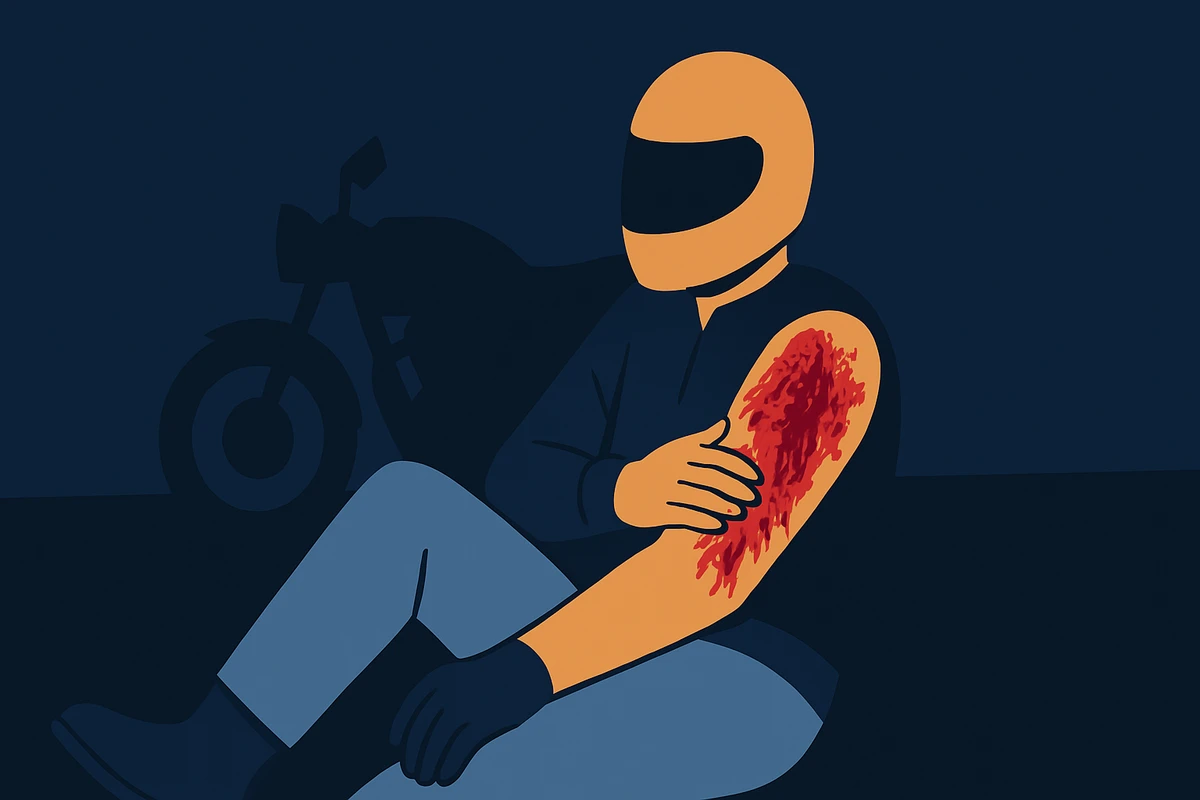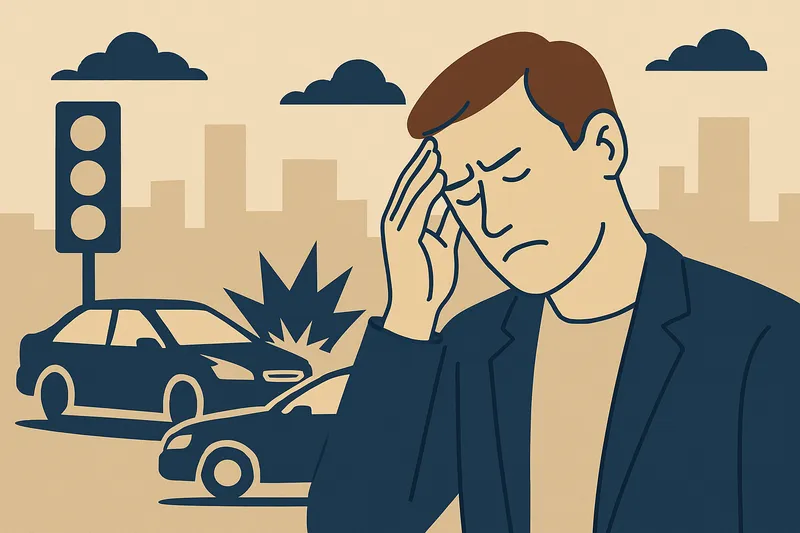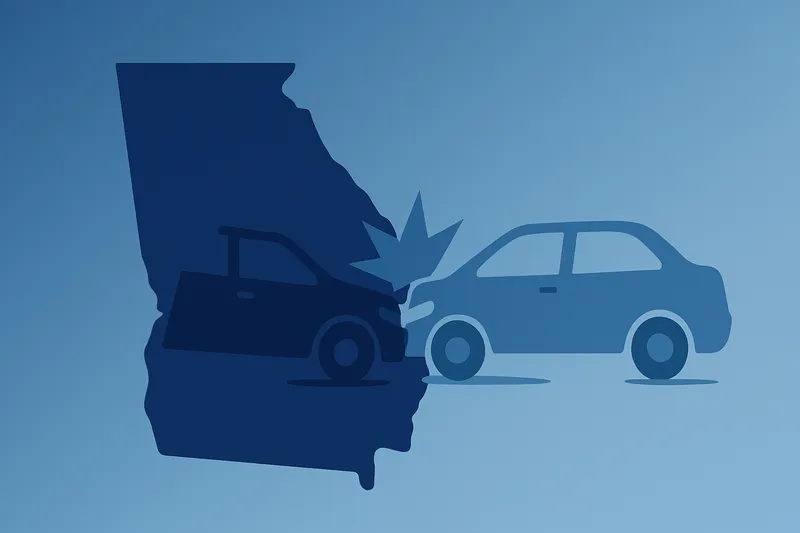Healing Time for Severe Road Rash After a Motorcycle Accident

Published: 3/31/2025
Road rash is the common term for skin abrasions caused by sliding across pavement, often affecting motorcyclists who crash and skid on asphalt. In a motorcycle accident, unprotected skin can be scraped off by friction, leaving a raw and painful wound. Such injuries range from mild scrapes to severe abrasions that remove all skin layers. The healing time can vary widely depending on the severity of the road rash. This article provides an informative overview of how long severe motorcycle road rash takes to heal, the stages of healing, proper treatment, and tips to speed recovery while preventing infection. It focuses specifically on motorcycle-related road rash injuries and what injured riders should know during recovery.
Road Rash in Motorcycle Accidents
Motorcyclists are especially prone to road rash because any exposed skin can be torn away if they slide or are thrown from the bike. When a rider lays the bike down or collides and skids across the road, the rough surface can shear off the outer skin. The affected area looks raw, red, and may bleed immediately after the crash. Common areas for motorcycle road rash include the knees, lower legs, shoulders, thighs, and even the face, since these body parts often hit the ground first. Unlike minor scrapes from everyday incidents, motorcycle road rash often covers a larger area and may contain embedded gravel or debris. Riders sometimes refer to mild road rash as a “raspberry” or “strawberry” due to its appearance. Severe cases, however, go much deeper and can pose serious medical risks like infection or permanent scarring.
Doctors categorize road rash similarly to burns, in “degrees” of severity. First-degree is superficial, second-degree is partial-thickness (deeper into the skin), and third-degree is full-thickness (all layers of skin are damaged). Motorcycle accidents can cause any of these, but high-speed crashes often result in second- or third-degree road rash. The more severe the injury, the longer the healing process and the more intensive the care required.
A fresh motorcycle road rash injury on the shoulder. This abrasion has removed the top layers of skin, leaving a raw, bleeding wound. Superficial injuries of this nature can heal in about two weeks with proper care, but deeper wounds that scrape through all skin layers take much longer and may require surgical treatment.
Severity Levels and Healing Timelines
Healing time for road rash can range from just days to many weeks or months, depending on how deep and extensive the injury is. Below is a general timeline by severity:
-
First-Degree (Mild) Road Rash: This involves only the outermost layer of skin (epidermis). It looks like a red, tender scrape with perhaps slight bleeding or oozing. These minor abrasions are painful but heal relatively quickly, often within about a week or two with basic care. Such superficial road rash usually does not leave significant scars. An example might be a rider who slid briefly and got a “rug burn” type injury on the arm – it stings but is mostly surface damage.
-
Second-Degree (Moderate) Road Rash: In this case, the abrasion goes deeper into the skin, affecting the dermis (the layer under the epidermis). Symptoms often include visible bleeding, swelling, and intense pain. There may even be exposed nerve endings or tendons in serious second-degree cases. Because more tissue must regenerate, healing takes longer – typically several weeks. Many moderate road rash injuries heal in about 2 to 3 weeks with diligent wound care, but some can take over a month if large or if complications arise. Scarring is common with second-degree road rash, though proper care can minimize it. Medical attention is advised, as these wounds have higher risk of infection.
-
Third-Degree (Severe) Road Rash: This is the most severe form, where skin is “gouged or flayed off,” and the wound can extend through all layers of skin down to fat, muscle, or even bone. The area may appear shiny or whitish (due to exposed tissue) or even have charred appearance if there was friction burn, and bleeding is heavy. Paradoxically, it might be extremely painful or sometimes less painful if nerves are destroyed. Third-degree road rash almost always requires professional medical treatment. These deep wounds take many weeks to months to heal. The initial skin regrowth might occur over 4–8 weeks (often with medical interventions), and complete healing of the skin may take several months. Even after the skin closes, survivors usually have permanent scars or discolored “traumatic tattoos” (dark debris embedded in skin) from the asphalt. In many severe cases, doctors must perform surgical debridement (to clean out dirt and dead tissue) and skin grafts to cover the wound. Skin graft surgery introduces new tissue to help close the wound and typically lengthens the recovery time. It’s not uncommon for the full healing process (including scar maturation) to stretch out for up to a year or even two years for the worst road rash injuries. During that time, the scar tissue gradually strengthens and fades in color, but it may never be as strong as the original skin (even at 3 months, healed skin is only ~80% as strong as pre-injury).
It’s important to note that these timelines are general guidelines. Every individual heals differently. Factors like the size of the wound, the rider’s age and overall health, and how well the wound is cared for can all influence healing speed. For example, a healthy young rider with a clean wound might heal faster than an older rider or someone with a medical condition. If multiple areas of the body have road rash (as is common when a rider rolls or slides, getting several abrasions at once), the body has to work on many injuries together, which can prolong recovery. Additionally, road rash often accompanies other injuries in a motorcycle crash (like broken bones or concussions), and those injuries may affect overall recovery time. In summary, minor cases heal in days to weeks, while severe road rash can take many weeks or months before the wounds fully close and stabilize.
Hemostasis (Stopping the Bleeding):
This phase begins immediately after the injury. Blood vessels at the wound site constrict and blood cells clump together to form clots. Essentially, your body is plugging the leaks. You’ll see a scab begin to form as the blood clot dries and hardens over the scrape. The scab acts as a temporary natural bandage, protecting the exposed tissue underneath from dirt and bacteria. Hemostasis typically occurs within minutes of the crash.
Inflammation
Once bleeding is controlled, the body sends in its clean-up crew. Blood vessels widen again to bring oxygen and nutrients to the area, and white blood cells flood the wound to fight any infection. During this stage, which lasts a few days, you’ll notice the classic signs of inflammation: the wound and surrounding skin might be red, warm, swollen, and painful. This is normal – it means your immune system is working to prevent infection and clear away debris. You might even see clear fluid or mild oozing; that fluid (plasma) helps cleanse the wound. It’s important during this stage to keep the area clean (through proper wound care) because the body is particularly vulnerable to infection now.
Proliferation (Growth and Rebuilding)
After a few days, the wound enters the proliferation phase. Now, the focus is on growing new tissue to fill and cover the wound. Your body generates new skin cells and blood vessels, and a protein called collagen is laid down to form connective tissue. In a deeper road rash, you might see granulation tissue, which is red, bumpy new tissue filling in the wound bed. For more superficial wounds, the new skin (epithelium) starts creeping in from the edges under the scab. This phase can start around 2–4 days after injury and typically continues for several weeks. During proliferation, a road rash might itch as it heals – itching is often a sign of new skin growth. You may also notice the wound contracting (getting smaller) as edges pull together. If scabs are present, they may begin to lift at the edges as skin forms underneath.
Remodeling (Maturation)
This is the final stage of healing, when the wound is closed and your body strengthens the new tissue. Collagen fibers rearrange and the skin becomes firmer and more flexible over time. Any scars will gradually fade in color and may flatten or soften. The remodeling phase begins a couple of weeks after injury and can last for months – sometimes up to a year or more for serious wounds. For example, a bright pink scar from a severe road rash might slowly lighten and improve in appearance over 6–12 months. Even though the wound looks “healed” long before this stage is complete, the body is still fortifying the area. Keep in mind that even after remodeling, the new skin may never be as strong as it was originally (most wounds regain at best ~80% of their original strength). It’s also during this phase that scar management (like using silicone gel or vitamin E, per a doctor’s advice) might help optimize the outcome.
These stages overlap, and there isn’t a sharp boundary between them. For instance, even as part of the wound is proliferating, another part might still be inflamed. With road rash, because the injury often covers a wide area, different parts of the wound might be in different stages at the same time. The key takeaway is that healing is a process – it starts immediately, but larger wounds especially will take time to rebuild and strengthen. Patience is important, but there are also active steps you should take to help each stage along, which we’ll cover next.
Treatment and Medical Care for Road Rash
Proper treatment is critical to ensure road rash heals as quickly and cleanly as possible. For motorcyclists, treating road rash involves two levels: immediate first aid/home care and professional medical care for severe cases. Taking the right steps after the accident can prevent complications like infection and may even reduce scarring.
First Aid and Home Care
Most mild to moderate road rash injuries can be managed at home with diligent care. Before touching the wound, wash your hands thoroughly with soap and water. This reduces the chance of introducing bacteria into the open wound. Rinse the road rash under cool running water or use a clean damp cloth to gently cleanse it. Remove as much dirt, gravel, or debris as possible – these often accompany motorcycle crashes. You may use mild antibacterial soap (like Dial®) to softly wash the area. Do not scrub harshly, as that can aggravate the injury. If debris is embedded, you can use sterilized tweezers to pick out particles carefully. Cleaning might cause some bleeding again, which is normal. Thorough cleansing is vital to prevent dirt from causing infection or “tattooing” the skin with dark particles later.
If you have an antiseptic solution (like diluted hydrogen peroxide or betadine), you can lightly irrigate the wound after washing, but plain water is often sufficient. Some riders carry a first aid kit with saline wash which can be used on road rash.
After cleaning, pat the area dry with a sterile gauze or clean towel (don’t rub it dry). Then apply a thin layer of antibiotic ointment (such as Bacitracin® or Neosporin®) over the entire road rash to kill bacteria and keep the tissue moist. Keeping the wound lightly moist (not wet) is key – “moist is key” for road rash healing, as it promotes faster skin regeneration. The ointment also prevents the wound from drying out and the dressing from sticking.
Cover the road rash with a sterile, non-stick dressing. You can use a non-adherent gauze pad (e.g., Adaptic® or Telfa® pad) or a specialized wound dressing. Secure it with medical tape or a wrap, but ensure it’s not too tight. Covering the wound protects it from further injury and keeps out germs, while also maintaining that moist environment for healing. Do not leave a serious road rash open to air – despite the old “let it breathe” myth, wounds heal faster when covered.
Change the bandage at least once a day, or whenever it becomes dirty or soaked. When removing the old dressing, do it gently. If it sticks, soak it with saline or warm water to loosen it rather than ripping it off (to avoid reopening the wound). After removing, repeat the gentle cleaning and reapply fresh ointment and a new dressing. Consistent wound care greatly reduces infection risk and helps the wound heal faster.
Manage Pain
Road rash, especially severe ones, can be very painful. Over-the-counter pain relievers like ibuprofen or acetaminophen can help reduce pain and also inflammation. If the wound is large, consider taking a painkiller about 30–60 minutes before your daily wound cleaning to make it more tolerable. For very severe road rash, a doctor might prescribe stronger pain medication, especially in the first week or two. Keeping pain managed is important because it helps you stay on track with necessary wound care.
Watch for Infection
During daily care, always inspect the wound for signs of infection. Warning signs include increasing redness or warmth around the area, swelling, yellow/green pus or foul-smelling drainage, or escalating pain after the first couple days. Also, fever, chills, or swollen lymph nodes can indicate a spreading infection. If you suspect infection, seek medical attention promptly. Minor infections can usually be treated with oral antibiotics, but if left untreated, an infection can spread and even lead to serious complications like sepsis (a body-wide infection).
Following these steps will address most uncomplicated road rash injuries. In fact, most road rash should heal within 2 weeks with good care (keeping the wounds clean and moist). Throughout the process, avoid picking at scabs that do form. Picking can reopen the wound and also increases scarring. Let scabs dry and fall off on their own as new skin grows underneath. It’s normal for healed skin to be pink and sensitive at first; applying moisturizer to the new skin once the wound is closed can help with itching and dryness.
When to Seek Medical Attention
Not all road rash can or should be managed at home. Severe road rash (and some moderate cases) require professional medical care. You should seek medical attention right away if you encounter any of the following:
-
If the road rash is so deep that you can see muscle, tendons, or bone, or large patches of skin are completely gone (third-degree road rash), you need emergency medical care. Such wounds often require surgical cleaning and possibly skin grafts.
-
If you can’t get the bleeding to stop within about 10-15 minutes of applied pressure, a doctor should evaluate the wound. Excess bleeding might indicate arterial involvement or very deep lacerations mixed with the abrasion.
-
If the rash covers a very large area (for example, an area bigger than your hand), especially if it’s a partial or full-thickness wound, it’s best to get medical care. Large wounds have higher risk for complications like infection and may need specialized wound dressings or grafts.
-
Face, Hands, Joints, or Genitals Involved: Road rash on the face (which could risk disfigurement or infection in sensitive areas like the eyes), on the palms or over joints (where movement might interfere with healing), or on the genital area should be seen by a medical professional. These areas often require careful treatment to heal correctly and minimize functional or cosmetic damage.
-
Embedded Debris: If there is debris (dirt, bits of asphalt, glass) that you cannot remove completely at home, a healthcare provider should treat the wound. They might need to perform a thorough debridement (removal of foreign material and dead tissue) under sterile conditions. Trapped foreign particles not only can cause infection but, if left in the skin, can cause permanent dark speckling (the “traumatic tattoo” effect) when the skin heals over them.
-
Signs of Infection: As mentioned, any signs of infection (increasing redness, pus, fever, etc.) warrant prompt medical evaluation. An infected road rash may require prescription antibiotics or even intravenous antibiotics for serious infections.
-
No Improvement or Slow Healing: If a road rash isn’t showing any signs of healing (for example, it’s not forming any new skin or scab after a week, or remains extremely raw and weeping), or if it’s not healed within about 2 weeks, have a doctor take a look. Wounds that take longer than two weeks to heal might be deeper than you thought or compromised by infection. Doctors might need to provide advanced treatments for chronic non-healing wounds.
At the hospital or clinic, treatment for severe road rash will include professional cleaning (sometimes the wound is scrubbed or pressure-washed in a controlled way to get all debris out – painful but important), stitches for any lacerated edges, tetanus shots (if you’re not up to date on tetanus vaccine, since road dirt can carry tetanus bacteria), and possibly surgery. For large full-thickness abrasions, skin graft surgery is a common treatment. In a skin graft, a surgeon takes healthy skin from another part of your body and transplants it to cover the wound. This helps close very large wounds faster and can reduce the risk of infection and deep scarring, although grafts themselves will leave some scarring. After any surgery, follow the wound care instructions given by your provider, as they may be a bit different or more involved than standard home care.
Severe road rash can sometimes have systemic effects too. Very extensive abrasions (like sliding a long distance) essentially create a type of burn on the body. Patients with large areas of road rash might be treated similar to burn victims – for example, they might need IV fluids to stay hydrated and prevent shock, and careful monitoring for hypothermia (since skin is a major organ for temperature regulation). Don’t hesitate to go to an emergency department after a motorcycle crash with severe road rash; doctors would prefer to treat it early than to see you later when it’s infected.
Tips for Faster Healing and Preventing Infection
Healing from road rash can be uncomfortable and slow, but there are several things you can do to support your body’s recovery. Here are some tips to speed up healing and avoid infections:
Keep the Wound Moist (but Clean): Avoid letting the road rash dry out and scab heavily. Using ointments or modern moist dressings helps the new skin cells grow more quickly. Research shows that “wet healing” with appropriate dressings helps wounds heal more efficiently than dry healing. Change dressings regularly to keep things clean – a moist environment is good, a dirty environment is not. Never reuse old bandages.
Don’t Pick or Scratch: Itching can be intense as the wound heals, but resist the urge to scratch or pick at scabs. Picking at scabs can reopen the wound and set back healing time, as well as increase infection risk. To help itchiness, you can apply unscented lotion to the intact healed skin around the wound or ask your doctor about safe anti-itch creams once the surface is closed.
Eat a Healthy Diet: Good nutrition provides the building blocks for repair. Protein is particularly important for wound healing – your body needs protein to generate new tissue. Make sure you’re eating enough calories and a balanced diet rich in lean protein, vitamins (especially Vitamin C and A which support skin healing), and minerals like zinc. Stay hydrated by drinking plenty of water, as dehydration can slow down the healing process.
Avoid Smoking and Alcohol: Smoking is known to slow wound healing because it decreases blood flow and oxygen delivery to the skin. People who smoke or have poor nutrition tend to face longer healing times. If you’re a smoker, try to cut back or quit while you recover, or seek help for nicotine patches or alternatives during healing. Excessive alcohol can also impair the immune system and healing, so moderation is advised.
Get Plenty of Rest: After a motorcycle crash, your body needs energy to repair tissues. Prioritize rest and sleep, especially in the first days and weeks. Avoid strenuous activities that might re-injure the area or cause the wound to rub and reopen. If the road rash is over a joint (like the knee or elbow), try to limit excessive bending of that joint and keep it elevated when possible to reduce swelling. Give your body the time it needs to do the repair work.
Prevent Infection with Hygiene: Always wash your hands before touching the wound or changing dressings (can’t be said enough!). Additionally, keep your environment clean – change your bedsheets regularly, wear clean, breathable clothing that won’t irritate the wound, and avoid submerging the wound in lakes or hot tubs while it’s open (to prevent exposing it to germs). If you’ve been sweating a lot (which can happen if you’re in riding gear in heat), clean the wound and change the dressing afterward, since sweat can harbor bacteria.
Follow Medical Advice: If a doctor gave you specific wound care instructions or antibiotics, follow them exactly. Take the full course of any antibiotics to fully eradicate bacteria, even if the wound looks better. Attend any follow-up appointments to ensure the road rash is healing properly. Everyone wants their injuries to heal faster, but skipping steps can backfire. As one source notes, serious road rash may take several weeks or more to heal, and adhering to care instructions is the best way to heal as quickly as possible.
Scar Care (Once Healed): After the road rash has fully closed up, you can take steps to improve the scar outcome. Keeping new scars out of the sun (or using sunscreen) prevents them from darkening. Some people use silicone gel sheets or vitamin E oil on scars, though you should consult a healthcare professional for recommended scar treatments. Moisturizing the new skin and doing gentle massage on the scar (when advised by a doctor) can also help remodel the tissue. Remember, some scarring is almost inevitable with severe road rash, but over time scars usually fade considerably. If “traumatic tattoo” debris remains, a dermatologist might improve it with laser treatments once the skin is healed, if the discoloration is a cosmetic concern.
By following these tips, you create the best conditions for your body to heal. Essentially, you want to keep the wound clean, protected, and supported by a healthy lifestyle. Many riders who have been through road rash will tell you that wound care is not the time to be tough or sloppy – be gentle and meticulous with your injury and it will pay off in faster healing.
Final Thoughts
Suffering a bad case of road rash in a motorcycle accident is painful, but with proper care most riders make a full recovery. Mild road rash can heal in under two weeks, while severe road rash may require months of healing and leave lasting scars. The journey to recovery involves multiple stages – from the initial clotting and inflammation through the long remodeling phase where scars mature. Along the way, good wound care and hygiene are crucial to prevent infection and complications. Always clean and protect the wound, and don’t hesitate to get medical help for deep or slow-healing abrasions.
For motorcyclists, one silver lining might be a renewed appreciation for safety gear. Many riders find that after experiencing road rash, they are more vigilant about wearing protective clothing (abrasion-resistant jackets, pants, gloves, and boots) every time they ride. Such gear can dramatically reduce the severity of road rash or even prevent it altogether by keeping your skin off the pavement. In the end, the best “treatment” for road rash is prevention, but if it does happen, knowledge of the healing process and diligent care will help you get back on your feet – and back on your bike – as soon as possible. Ride safe and heal well!
Related Articles



